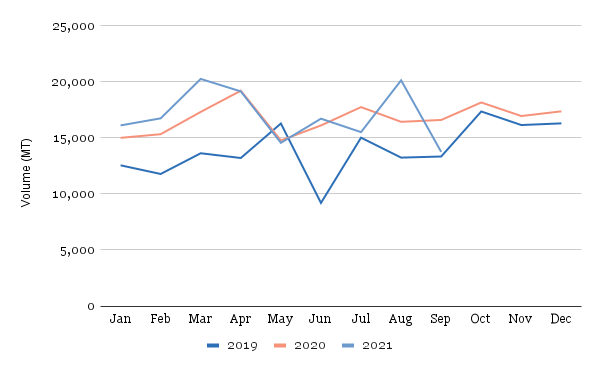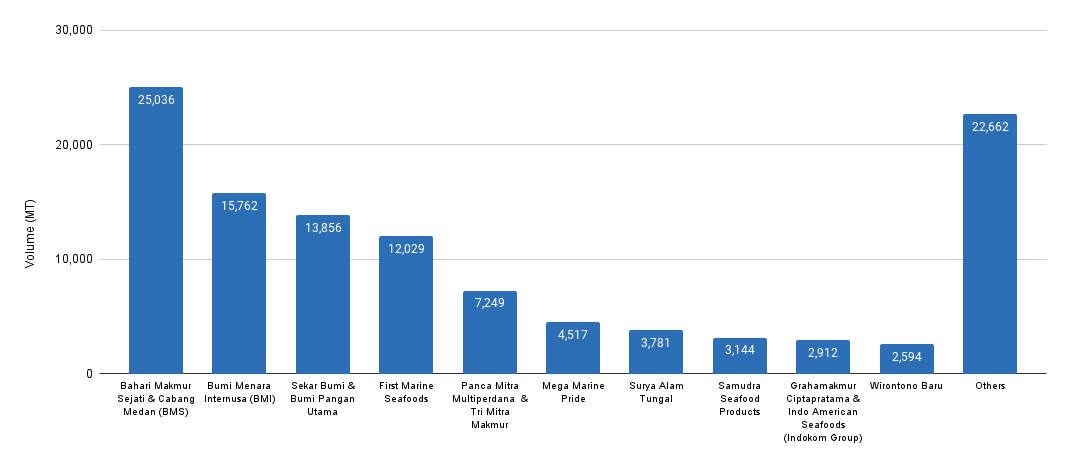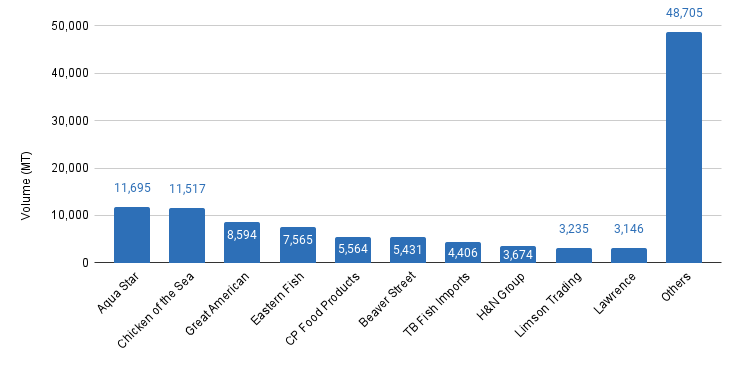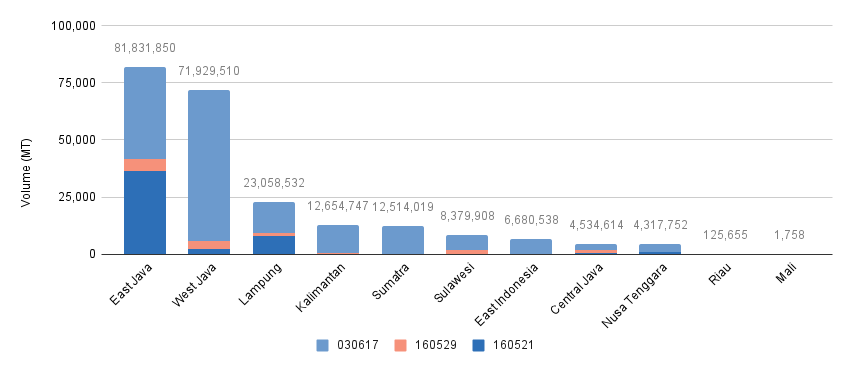Indonesia’s official export data normally runs significantly behind. Therefore, it’s sometimes difficult to have an up-to-date understanding of Indonesia’s shrimp export situation. In this third short October blog, I’ll look at data from Indonesia’s Fish Quarantine and Inspection Agency (FQIA/BKIPM) which reports the live weight volume of L. vannamei exports tested for exports on a real-time basis.
I also think it’s useful to complement BKIPM’s data with a look at who the big exporters and importers of Indonesian shrimp are for the US market. Together with Angel Rubio, senior analyst at Urner Barry Consulting, and using Urner Barry’s Foreign Trade Data website, we’ve come up with a detailed overview. Although the data shown in Figures 2 and 3 is always incomplete as a certain volume of exports and imports is not declared under the company name but anonymously, this is the best way to get an overview and to make estimates of importers and exporters trade volumes in relation to the total trade volume.
In this blog, I’ll also share a few insights into the regionality of Indonesia’s shrimp exports.
The Shrimp blog is sponsored by Grobest, Inve Aquaculture, DSM Animal Nutrition, American Penaeid Inc., Zeigler Nutrition, Aqua Pharma Group, Mega Supply, and Undercurrent News.

2021 Exports Outperformed 2020 from January-March but Have Fluctuated since Then and Seem to Be behind for October as Well
Industry insiders and analysts, including myself, anticipate that new intensive shrimp farms will be built, and we all expect that these will drive Indonesia’s export volumes up. While Indonesia, according to BKIPM’s data, managed to drastically increase its L. vannamei shrimp processed for exports from just below 170,00 MT in 2019 to just over 200,000 MT in 2020, it seems that this year the volume of L. vannamei processed for exports will be flat at best.

So far, in 2021, around 153,000 MT of L. vannamei has been processed for exports (Figure 1). During the first couple of months, exports outperformed 2020. However, since then, exports have fluctuated and due to considerable drops in July and September, the volume is now just around 2,000 MT above last year’s figures. Looking at October’s numbers to date (11,152 MT on the 26th of October), exports are behind by almost 3,000 MT compared to October 2020. As a result, 2021’s year total now runs slightly behind 2020.The drop in exports in some of the recent months is certainly a result of COVID-19-related restrictions on the food service segment and seafood processing industry.
Figure 1: Indonesia’s L. vannamei shrimp processed for exports according to BKIPM

Source: BKIPM, MMAF
Indonesia Has Become Even More Dependent on the US for Its L. Vannamei Exports
A quick look at Indonesia’s official export data reveals that over the first 7 months of the year, Indonesia managed to increase its exports to the US by about 10%, i.e. an increase of about 10,000 MT. However, its exports to Japan have been mostly flat while Indonesia saw its exports to China shrink to around 2,600 MT. The market share of the US in Indonesia’s total exports increased from just below 60% in 2020 to just over 65% in 2021. In terms of its share in Indonesia’s L. vannamei exports, the US might even represent up to 80% as some of the other markets also buy P. monodon and wild-caught shrimp.

The Top 4 and Top 10 Indonesian Exporters, Respectively, Represent 60% and 80% of Indonesia’s Shrimp Exports to the US
While the numbers provided in Figure 2 are not watertight, they’re a good indication of the level of consolidation in Indonesia’s shrimp processing and exports industry. The top 4 exporters to the US – Bahari Makmur Sejati (BMS), Bumi Menara Internusa (BMI), Sekar Bumi, and First Marine Seafoods – jointly have a 60% market share. The other top 10 players jointly add 20% to that, and the top 10 altogether represent 80% of total exports to the US. Keeping in mind that the US might represent over 80% of Indonesia’s total export market for L. vannamei, these 10 companies are simply Indonesia’s largest L. vannamei processors and exporters.

Figure 2: An estimation of the export volumes to the US of Indonesia’s top 10 shrimp exporters

Source: Urner Barry Consulting using Urner Barry’s Foreign Trade Data (www.foreigntradedata.com)
Indonesia’s major vertically integrated shrimp company, CP Prima, is absent from the data. The company used to run a couple of mega-farms through a satellite farming program but has, in recent years, reorganized its company structure and now buys shrimp for processing largely on the open market. CP Prima has clarified to me that, contrary to most of the other major exporters which may export 85%-100% of their products to the US, CP Prima is not focusing on the US that much. CP Prima’s exports to the US in 2021 only amount to 1,325 MT, one-third of its total exports. With 4,000 MT in total, CP Prima is still an overall “top 10” exporter of Indonesian shrimp. But, according to the company, the majority of its exports are targeted at Asian markets and the EU.

Top 25 and Top 10 US Importers, Respectively, Represent 81% and 68% of the Total Shrimp Volume Imported from Indonesia
Also imports into the US are relatively consolidated. Rubio’s data shows that the top 25 importers of Indonesian shrimp represent 81% of total imports while the top 10 (Figure 3) represent 68%. According to Rubio, this is more consolidated than US imports from India where the top 25 importers would only account for around 58% of total imports. The biggest buyers are the same as in India with Aqua Star (part of the Red Chamber Group) and Chicken of the Sea (part of Thai Union) leading the pack. What is different is that whereas many of the large Indian exporters have their own import divisions in the US, the large Indonesian players are not applying the same strategy but instead deal with traditional US importers.

Figure 3: The top 10 US importers of Indonesian shrimp from Jan.-Sept. 2021

Source: Urner Barry Consulting using Urner Barry’s Foreign Trade Data (www.foreigntradedata.com)
Eastern Java Is the Center of Indonesia’s L. Vannamei Processing Industry but Western Java Follows Closely
Indonesia’s Ministry of Marine Affairs and Fisheries, through the Indonesian Statistics Office, every year publishes a report with regional export data. Although this report is a bit hard to digest as the data isn’t aggregated or analyzed, I’ve aggregated the data per state myself and compiled the shrimp export volumes per province (Figure 4). This provides some notable insights. First of all, whereas new shrimp farming developments are also occurring outside Java, shrimp processing is still largely concentrated on the island. Processing companies in other provinces, such as in Sulawesi and Nusa Tenggara, still only account for minor export volumes. East, West, and Central Java combined accounted for 97% of total Indonesian shrimp exports in 2020.

Figure 4: Indonesia’s shrimp exports per province in 2020

Source: MMAF, BPS
While East Java is home to the processing operations of companies like BMI, Panca Mitra Multiperdana, and Mega Marine Pride, West Java is home to companies like BMS and First Marine Seafoods. Sekar Bumi has factories both in East and West Java. Looking at the dominance of value-added products (160521 and 160529) in East Java, this can largely be explained by the presence of BMI in particular and also Sekar Bumi, which are Indonesia’s largest exporters of further value-added products in particular, such as breaded shrimp. Mega Marine Pride is also a major exporter of cooked L. vannamei shrimp.
Conclusion
Indonesia so far remains a relatively small L. vannamei exporter compared to other countries like Ecuador, India, and Vietnam. However, its processing industry is relatively consolidated with large players such as BMS and BMI dominating exports. Interestingly, Indonesia’s dependence on the US market has not translated into Indonesian companies having major import divisions in the US. Instead, the US’s large well-known importers such as Aqua Star, Chicken of the Sea, and Great American Seafood dominate US imports from Indonesia. With the promise of Indonesia’s shrimp production increasing due to further expansion of intensive shrimp farming, I’m curious to see how Indonesia’s shrimp processing and exports industry will further develop and possibly witness new processing facilities popping up close to the locations where new shrimp farming clusters are established. I’ll keep you posted on future developments.